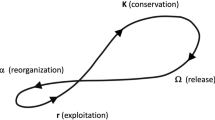Abstract
UNESCO designates the areas of biological, geological, and evolutionary importance all over the world as the Natural World Heritage Sites (‘sites’). These sites are all unique, but not equally popular with the tourists. This study quantifies the effect of population, percapita income, and number, area and access on the number of visitors to the sites. The results suggest that good infrastructure for tourism and civil order may be more important than population or income for the number of visitors. The study identifies the policies and institutions that can increase the popularity of the sites. It argues that the sites can promote development, build consensus on conservation, and advance social harmony.
Similar content being viewed by others
References
R. Costanza R. d’Arge R. de Goot S. Farber M. Grasso B. Hannon et al. (1997) ArticleTitleThe value of the world’s ecosystem services and natural capital Nature 387 253–260
G.C Daily B.H. Walker (2000) ArticleTitleSeeking the great transition Nature 403 243
G.C. Daily (1997) Nature’s Services Island Press Washington, DC
Dhakal S. 2003. Nepal’s Economy Gets Chill from Insurgency Heat. Us.oneworld.net/article/view/ 66859/1.
Ecotourism Statistical Fact Sheet 2001. http://www.ecotourism.org/textfiles/stats.txt (October 12, 2001).
How Skiing came to New England 2001. http://www.thinkquest.org/library/lib/site_sum_outside. html?tname=15967 & url=15967 (December 1, 2001).
Human Use of Natural World Heritage Sites: A global overview 2001. http://www.wcmc.org.uk/wh/reviews/human/toc.htm (July 17, 2001).
Jayaraman K.S. 1996. ‘Indian Ginseng’ brings royalties for tribe. Nature 381: (16 May 1996).
S. Jha (2000) ArticleTitleConservation and preservation through participation in two Indian projects: a policy perspective AMBIO 8 527–528
Jha S. and Bawa K.S. 2002. The Economic and Environmental Outcomes of Microfinance Projects. Ecological Economics (in review).
D.G. Kleinbaum L. Kupper K.E. Muller (1988) Applied Regression Analysis and Other Multivariable Methods Duxbury Press Belmont California
J.A. McNeely (1999) Mobilizing Broader Support for Asia’s Biodiversity: How Civil Society Can Contribute to Protected Area Management Asian Development Bank Manila Phillipines
Natural Heritage Sites-Protected Areas Program 2001. http://www.wcmc.org.uk (October 15, 2001).
Our Past Our Future. 2003. http://whc.unesco.org/nwhc/pages/sites/main.htm (accessed January 9, 2004).
D. Pimentel C. Wilson C. McCulam R. Huang P. Dwen J. Flack Q. Tran T. Saltman B. Cliffal (1997) ArticleTitleEconomic and environmental benefits of diversity Bioscience 47 747–757
A.R.E. Sinclair D. Ludwig C. Clark (2000) ArticleTitleConservation in the real world Science 289 1875
USAID (United States Agency for International Development) 2003. Win–Win Approaches to Development and the Environment Ecotourism and Biodiversity Conservation. http://www. usaid.gov/pubs/usaid_eval/ascii/pnaby204.txt accessed Nov. 5, 2003.
Whitbourn P. 2002. World Heritage Sites-the first thirty years. www.sal.org.uk/lectures/download/ worldheritagesites140202.rtf (accessed Jan. 9, 2004).
InstitutionalAuthorNameWorld Bank (2000) World Development Report 2000/01 Oxford University Press Oxford New York
World Bank 2002. Private Participation in Infrastructure. www.rru.worldbank.org/resources. asp?results=true (July 31, 2002).
Author information
Authors and Affiliations
Corresponding author
Rights and permissions
About this article
Cite this article
Jha, S. Can Natural World Heritage Sites promote development and social harmony?. Biodivers Conserv 14, 981–991 (2005). https://doi.org/10.1007/s10531-004-7837-0
Received:
Accepted:
Issue Date:
DOI: https://doi.org/10.1007/s10531-004-7837-0




